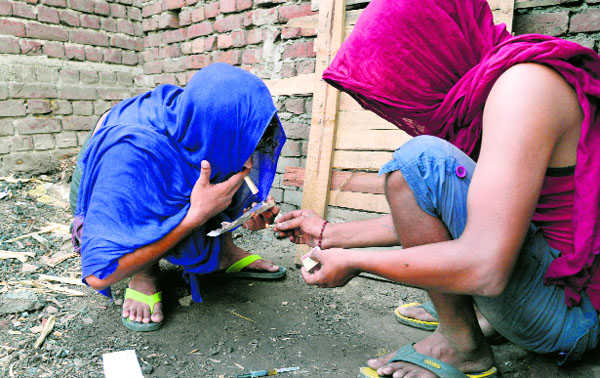
Substance abuse is a psycho-socio-medical problem. REUTERS
PPS Gill
Senior journalist and former Information Commissioner, Punjab
Currently, reports of deaths related to drugs in the media are causing ripples of fear and anxiety across Punjab. Neither is the menace of drug abuse new nor is its politicisation. Despite change of government, 'oath and claim', apparently, the infrastructure and apparatus of drug trafficking and consumption are intact. Even registration of thousands of cases under the NDPS (Narcotic Drugs and Psychotropic Substances) Act, 1985, against small-time carriers and couriers (barring exceptions), has made little impact. The shoving of petty addicts into rehabilitation centres and clinics has also not helped.
Substance abuse is essentially a 'psycho-socio-medical' problem. Scores of surveys/ studies conducted in the past two decades by institutions, including state's own, have come up with causes and remedies. Yet, successive governments have taken only baby steps.
The most striking feature of these surveys/studies was the manner in which the SAD-BJP government 'rubbished' them, including the one by the Society for Promotion of Youth and Masses (SPYM), the National Drug Dependence Treatment Centre, All-India Institute of Medical Sciences, New Delhi, conducted in collaboration with the Punjab's Department of Health and Family Welfare (February-April 2015). The then Deputy Chief Minister dubbed the findings as a 'conspiracy to defame' the state. Now he does not want the fight against drug abuse to be 'politicised'. Yet, he targets Congress. If the SAD-BJP was in 'denial mode' earlier, it is now guarded in comments.
To deal with drug terrorism, the Cabinet's decision to recommend to the Centre an amendment in the NDPS Act was to add 'death penalty' for drug peddlers. This provision already exists in the Act for those held guilty for the second time. How deterrent and effective has this Act been since its promulgation? The common perception is that the establishment knows who all are involved, yet is unwilling to act. The establishment itself is 'stained', given the 'dubious' role of its instrumentalities. The nexus between drug cartels, organised criminals, politicians and enforcement agencies has aggravated the problem. It is time to break the nexus between traffickers and their supporters in the establishment, if the state is to shrug off the tag of Udta Punjab.
And for public consumption, the Cabinet has formed a 'monitoring committee' and a 'working group'. Understandably, experts have rejected these steps. Ostensibly, such laws and acts are no deterrent for offenders because quick and effective implementation is missing. Otherwise, there would not have been a chain of Nirbhaya episodes after incorporating 'death' for rapists. Rattled by the drug deaths — 23 in June alone, in just five districts of Ferozepur, Tarn Taran, Amritsar, Ludhiana and Faridkot — the director-general of police has held a review meeting, even as the Special Task Force's efforts remain 'work-in-progress'. That the high court is seized of the issue is a different story. Social media is abuzz with the observance of a 'black week' to focus the government’s attention on the vexed problem.
Expectedly, the government's focus seemingly remains on targeting the drug network to reduce supply, introduce out-patient opioid-assisted treatment and improve the conditions in de-addiction centres/clinics, and build mass awareness on drug abuse and reduce its demand. Will it succeed?
The Congress leadership is on the back foot, defending its actions and apportioning the blame for recent deaths as much to 'adulterated' heroin (chitta), because of turning off the main supply inlets, as it claims, as on the 'misuse' of anti-addition drugs by taking these 'intravenously' to satisfy their craving.
Substance abuse is not a recent phenomenon. Even before Partition, opium, alcohol and poppy husk were widely consumed. And, post 1947, people graduated to heroin and became 'addicts' or, as the World Health Organisation, says 'dependent' on opioid derivatives. As per the WHO, the categories of drugs other than opioid (and tobacco and alcohol) that may also cause dependence are cannabis, sedatives, hallucinogens, cocaine, amphetamine type stimulants and inhalants.
Punjab has the dubious distinction of having as many liquor shops as there are primary schools: in the bracket of 12,000-14,000, each. Liquor fetches handsome revenues. In fact, Punjab's reluctance to treat the drug situation as a full-blown crisis is partly because of the state government's dependence on revenue from alcohol. The Comptroller-General of India had reported a 59 per cent hike in liquor consumption in Punjab between 2005 and 2010.
Even smuggling of heroin from Pakistan along the 553-km international border has escalated. The Border Security Force seized 377 kg of heroin in 2017, a spike of 18 per cent over 2016; it was worth Rs 1,365 crore. It is believed that with low returns from farming, people living on the border with lands across the fence, act as conduits and get paid as much as Rs 2 lakh per kg.
In fact, from narco-terrorism in the mid-1980s, heroin trafficking from across the border rapidly picked up in 2000. The question is not of quantifying the substance abuse but its cascading impact on the youth, affected families and the state.
Several factors are responsible for causing the drug problem in Punjab and the Green Revolution is one. It had set high lifestyles and living standards, but down the decades, these were difficult to maintain, as yesteryear farming crisis caused an over-reliance on cash crops while returns dwindled and unemployment spiked. Easy availability and access to drugs is another factor.
The SPYM report stressed it would require a healthy mix of short and
long-term strategies and inter-sector coordination among stakeholders, besides a spirit of 'helping affected people', not 'punishing them'. Coordination between sectors involved in helping reduce the supply and demand of drugs and spreading awareness of their harmful effects is necessary. All these three approaches have their distinct role to play. Over-relying on any one of the three is likely to be detrimental.



























